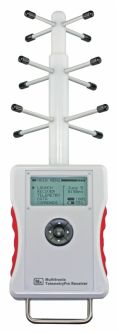New features included in version 3.0
- Additional flight results pages have been added that display more information about the flight. Especially for multi-stage flights. Now shows staging delay, burn time and max acceleration for each stage. Also shows altitude and velocity at ignition and at burn-out for each stage. It now reports how early or late the apogee deployment charge fired. It also reports both vertical and horizontal velocity when the deployment charge fired. Other general improvements provide additional information.
- Significant improvements to the locator functionality. The user can now more easily navigate to the last known location of the rocket even if a landing site was never determined due to loss of signal. The locator can also extrapolate to a projected landing site based on the last known GPS coordinates along with altitude, descent rate and drift rate. The user can now easily switch the locator back and forth between live data, last downlink packet or data recalled from a previous flight. The user can now even directly enter coordinates if desired.
- Significant improvements to the detection and announcements associated with "off nominal" flights. Such as low angled non-vertical flights, shreds or ballistic returns.
- Streamlined the descent phase call outs for altitude, velocity and distance. Made changes to avoid unnecessarily repeating descent velocity or distance when they have not significantly changed.
- Added automatic real time calibration of accelerometer data by using GPS information.
- The owner's name and phone number can now be displayed on the first screen at power-on. The owner can enter this information in the settings menu. It helps avoid getting receivers mixed up between users at large launches. It may also help get a borrowed or lost receiver back to the owner.
- Added a new Australian voice named "Lisa". The Australian version also allows a user to select the preferred units (metric or imperial) for velocity, distance, acceleration and temperature. However, altitude is only displayed and announced in feet. Also supports Australian time zones and automatic AUS daylight savings time. Australian firmware is version 3.0.0.1.
- Some settings will now retain their value even after a power cycle. This includes the user's preferred units of measure, speaker volume, 12/24 hour time format and time zone correction offset.
- The bearing to the rocket is now announced and displayed in degrees with respect to true north. Previously, it was in degrees from magnetic north and was not exactly accurate everywhere in the USA or AUS.
- Suppressed some announcements made at apogee on low altitude flights so that Kate/Lisa spend less time talking about max velocity, max acceleration, apogee bearing and apogee distance. This gives more time to make call-outs during descent. The resulting flight commentary is much cleaner for low altitude flights (less than about 6000 feet). Higher flights are unaffected by this change.
- Simplified the drift rate call out to no longer mention direction of drift. It was confusing people who thought it was the direction to look for the rocket when in reality it is the direction the rocket is drifting. Only drift rate in feet per second will now be announced.
- Fixed a bug that skipped an announcement about the main parachute when it deploys early.
- Fixed fault 181 that would occasionally be reported when trying to download the recorded audio using the Flight Data Analyzer software.
- Other bug fixes and improvements.


